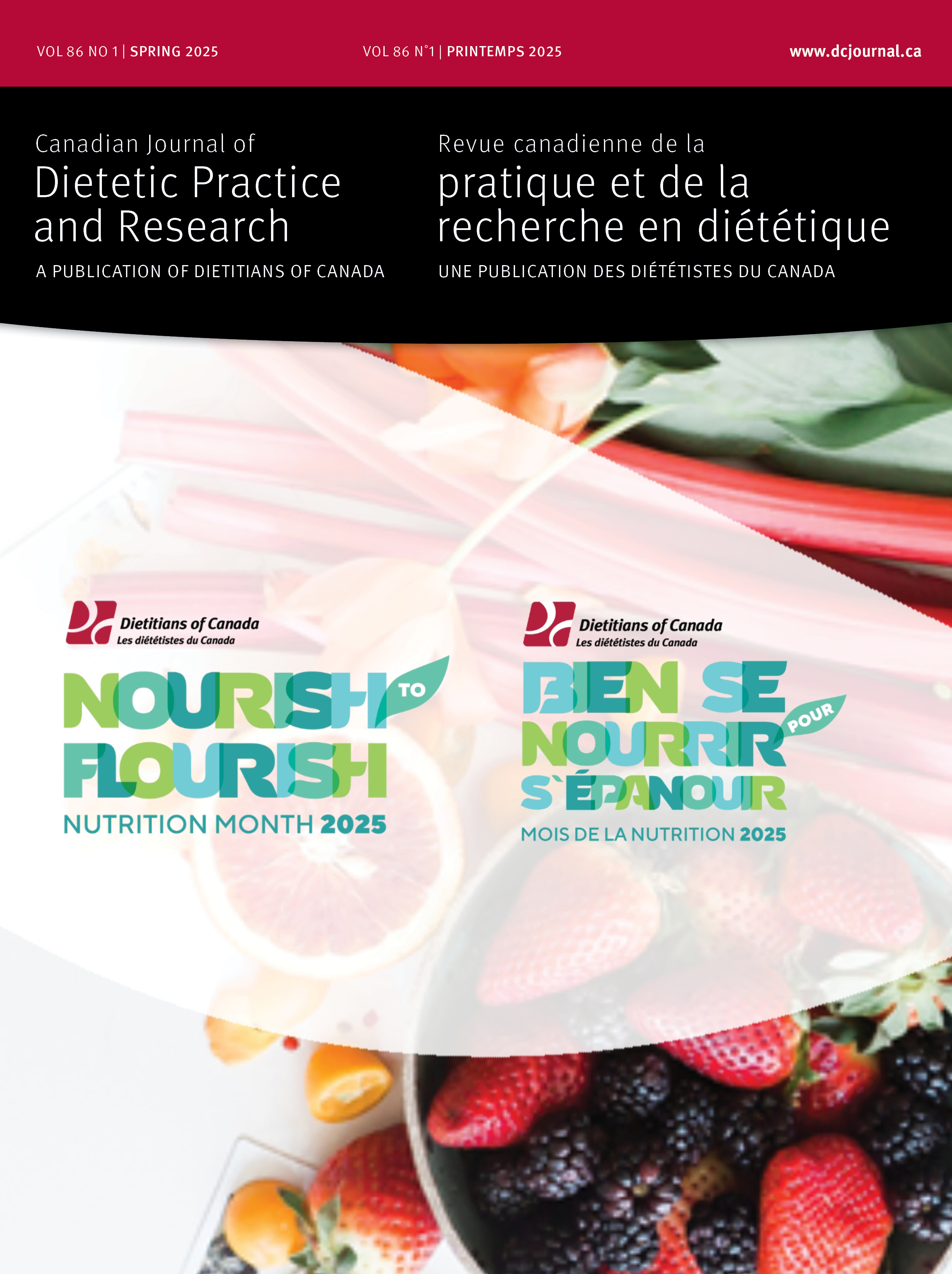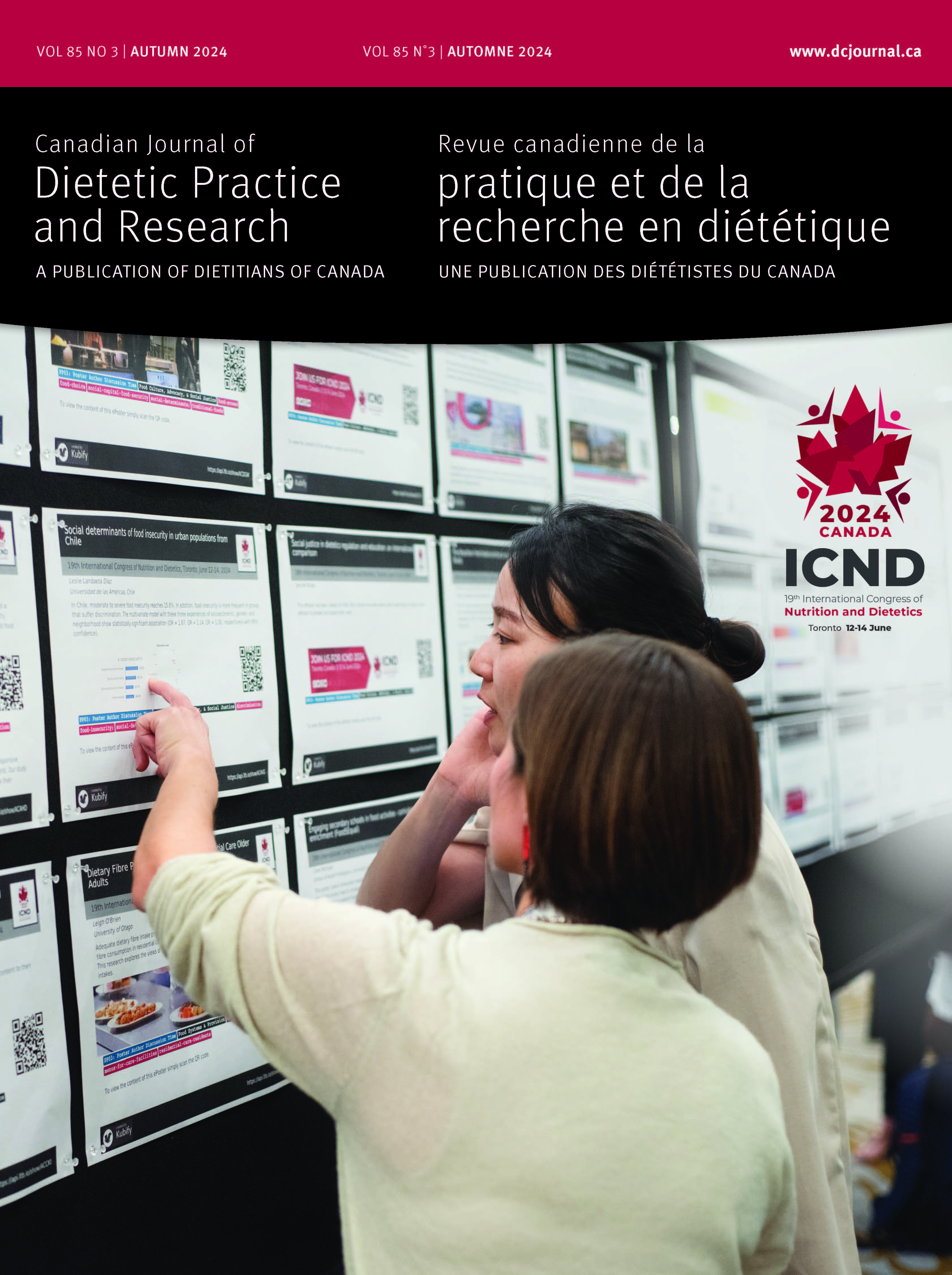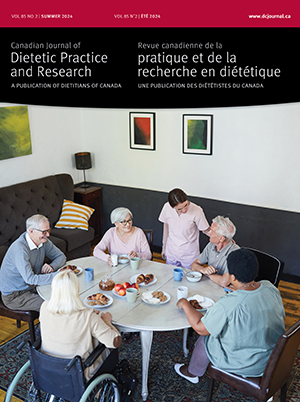Volume 79 • Number 3 • September 2018
Editor's Message
Research
Purpose: To compare sales of Food Resources and Education for Student Health (FRESH) Approved versus non-FRESH Approved menu cycle items pre- and postimplementation of the FRESH program.Methods: Sales data from 2011–2015 of FRESH Approved versus non-FRESH Approved menu items were analyzed. Fruit and milk items sold, net sales, and the cost of free fruit and milk redeemed through the FRESH Reward Card (FRC) program, were also analyzed.Results: FRESH Approved items sold more often than non-FRESH Approved items in the latter 2 years (P = 0.01). Prices of FRESH Approved menu items were significantly lower than non-FRESH Approved items for all years (e.g., $1.52 ± $0.94 vs $2.21 ± $1.02 per serving in 2014–2015; P < 0.001). Across all FRESH implementation years, FRESH Approved menu items were found more often on the 6-week menu (P < 0.05). The number of fruit items sold increased from a baseline of 143 052 to 170 954, and net sales increased from $135 450 to $154 248 after 3 years of the FRC implementation.Conclusions: FRESH Approved items were less expensive, available more often, and had higher sales. The FRC increased net fruit sales despite the cost of free fruit. Highlighting and reducing the cost of healthy foods are promising practices to improve campus food environments.
Purpose: Parents influence the foods their children consume and often provide proxy reports of this intake. One way parents exert this influence is by providing home-packed lunches. This study compared parental reports of foods packed in children’s lunches with what was actually packed and identified parental barriers and facilitators to packing lunches.Methods: Grade 3 and 4 student–parent dyads (n = 321) in 19 elementary schools in Ontario participated. Parental reports and actual packed lunch contents were collected via self-administered surveys and direct observation, respectively. Parental barriers and facilitators were obtained through open and closed survey questions.Results: Median portions packed were significantly higher for sugar-sweetened beverages and snacks and significantly lower for fruits, fruit juice, vegetables, milk/alternatives, and meat/alternatives than parents reported. Packing a healthy lunch was “important/very important/of the utmost importance” for 95.9% of respondents, and 97.5% perceived their nutrition knowledge as “adequate/good/very good”. Barriers to packing a lunch included: child’s food preferences, time, finances, allergy policies, and food safety. Nutrition resources, observing other children’s lunches, child’s input, and planning ahead were identified as facilitators.Conclusions: Strategies to improve packed lunches should move beyond parental nutrition knowledge and importance of lunch packing to address parental barriers and facilitators.
Purpose: To assess awareness of omega-3 fatty acids (FAs) and their possible health effects among young adults.Methods: An online survey was deployed to young adults. Questionnaire development involved identification of topic areas by content experts and adaptation of questions from previous consumer surveys. Focus groups and cognitive interviews ensured face validity, feasibility, and clarity of survey questions. Degrees of awareness and self-reported consumption were assessed by descriptive statistics and associations by Cochran’s Q tests, Pearson’s χ2 tests, Z-tests, and logistic regression.Results: Of the 834 survey completers (aged 18–25 years), more respondents recognized the abbreviations EPA (∼51%) and DHA (∼66%) relative to ALA (∼40%; P ≤ 0.01). Most respondents (∼83%) recognized that EPA and DHA have been linked to heart and brain health. Respondents who used academic/reputable sources, healthcare professionals, and/or social media to obtain nutritional information were more likely to report awareness of these health effects (P ≤ 0.01). Finally, 48% of respondents reported purchasing or consuming omega-3 foods, while 21% reported taking omega-3 supplements.Conclusions: This baseline survey suggests a high level of awareness of some aspects of omega-3 fats and health in a sample of young adults, and social media has become a prominent source of nutrition and health information.
Perspecitves in Practice
There is growing interest in use of local food within health care institutions such as hospitals and long-term care homes. This study explored stakeholder perspectives on (i) influences on local food use and (ii) strategies that support success and sustainability of use in health care institutions. Fifteen participants who were institutional leaders with experience in implementing or supporting local food use in health care institutions in Ontario were recruited through purposeful and snowball sampling. A semi-structured interview was conducted by telephone and audio-recorded. Qualitative content analysis identified that influences on local food use were: product availability, staff and management engagement, and legislation and resources (e.g., funding, labour). Several strategies were offered for building and sustaining success including: setting goals, requesting local food availability from suppliers, and more clearly identifying local foods in product lists. The influences and potential strategies highlighted in this paper provide a greater understanding for dietitians and food service managers on how local foods can be incorporated into health care institutions.
The study purpose was to describe dietary intake and the factors influencing micronutrient supplements (MS) use in Celiac Disease (CD) ± Type 1 Diabetes (T1D). Three-day food records collected from parents of youth (3–18 years) with CD (n = 14) ± T1D (n = 10) were assessed for macro and micronutrient intake, diet quality (DQ), glycemic index (GI), glycemic load (GL), and food group intake. Focus group methodology and thematic concept analysis were conducted to determine factors influencing adolescent MS use. Mean ± SD age was 11 ± 4.4 (CD) and 13 ± 3.7 (CD + T1D) (P = 0.32). Body mass index was within healthy reference ranges (17.9 ± 2.5 [CD]; 19.3 ± 3.8 [CD + T1D] kg/m2; P = 0.61). The majority of youth with CD ± T1D (>90%) had high intakes of sugar and saturated fat, had high GI and GL, and met food serving recommendations and DQs that were indicative of “needs improvement.” With the exception of vitamin D, vitamin E, folate, calcium, and potassium, youth in both groups met the estimated average requirements (EAR) for most micronutrients. MS use corrected suboptimal vitamin D intake; however, vitamin E, folate, calcium, and potassium intake remained below the EAR. Variables influencing adolescent MS use included daily routine, health professional influence, disease management (CD + T1D), and lack of knowledge about the need for MS. Strategies to elicit adolescent MS use varied between parent and adolescents.
Report
Purpose: University students may be at risk for food insecurity (FI) due to low income coupled with rising tuition, housing, and food costs. This study aimed to determine the prevalence of FI and potential correlates among students at a small, rural Canadian university.Methods: Health Canada’s 10-item household food security survey module (HFSSM) was adapted to assess food security status within the postsecondary student population. An additional 11 items measured food access and demographics. The validated, web-based survey was distributed by email and completed by 218 students (15.6% response rate). Participants were classified as food secure, moderately food insecure, or severely food insecure using the HFSSM Adult scale.Results: An overall FI rate of 37.2% was observed. This included 25.7% moderately food insecure and 11.5% severely food insecure. Students in higher years of study and who lived off campus had higher rates of FI.Conclusions: FI appears to be a significant concern for university students and has potential health and academic implications. Further research is needed to clarify the determinants and extent of FI for postsecondary students and to develop strategies to mitigate the prevalence and effects of food insecurity in these young adults.
Purpose: In the province of Ontario, a new law requires restaurants and food service providers, with more than 20 locations in Ontario, to prominently list the calorie content of their food items on the menu. This study examined if the new calorie information shifted the Ontario consumer’s ability to more accurately estimate calories.Methods: Using an online survey, consumers (n = 665 non-Ontario control and n = 694 Ontario) were asked to estimate the calories of a popular menu item (a cheeseburger) prior to this new legislation and 3 months and 6 months after the introduction of the mandated calorie labels on menus.Results: Early results suggest that one cannot yet see a clear overall change in the Ontario consumer’s ability to estimate calories (based on 1 popular food item) since the introduction of mandated calorie labels on menus, although the most recent survey data suggest promise.Conclusions: Consumers, not just in Ontario, are poor at estimating calories. Repeated exposure to the calorie information now posted on most Ontario fast-food menus is an educational initiative expected to show benefits in the future, but additional time is required for measurable increases in consumer knowledge.
Recognition
OPEN ACCESS
This article is a version of the Ryley–Jeffs Memorial Lecture, delivered on 8 June 2018. It discusses weight bias and the intersections with homophobia, racism, and misogyny, and how these impact health. While the dominant discourse attests that people can lose weight and keep it off, evidence informs us that maintenance of weight loss is unlikely. Using a flawed epistemological framework, obesity has been declared a disease, and weight bias been perpetuated. Weight bias is pervasive, both in the general public and amongst health professionals, often using inappropriate tools to assess the impact of weight on health. This contributes to overlooking the life circumstances that truly cause morbidity: social determinants of health such as income, social connectedness and isolation, adverse childhood experiences, and cultural erasure. A variety of tools dietitians can use to appropriately assess health risk are provided, along with examples of actions that can be taken to reduce weight bias. Dietitians who are leading the profession in taking action against weight bias and stigma are profiled.
Canadian Foundation For Dietetic Research
OPEN ACCESS
Vancouver, British Columbia was the host city of the 2018 Dietitians of Canada Annual Conference.Through the support of Dietitians of Canada (DC) and Canadian Foundation for Dietetic Research (CFDR), the 2018 Research Showcase was an informative exchange of research and experience-sharing efforts. The submissions for this year’s CFDR event represented the diversity of dietetic research conducted within Canada.The 2018 Research Showcase highlighted the Early Bird abstracts in 2 formats; some as 10 minutes oral sessions and others as ePosters with a short oral component. The Late Breaking abstracts were displayed as ePosters.This research event would not be possible without the commitment and dedication of many people. On behalf of DC and CFDR, we would like to extend a special thank you to members of our Early Bird abstract review committee: Susan Campisi (University of Toronto); Elaine Cawadias (Retired); Andrea Glenn (St. Francis Xavier University); Mahsa Jessri (University of Ottawa); Jessica Lieffers (University of Saskatchewan). Members of the Late Breaking abstract review committee included: Laurie Drozdowski (University of Alberta); Laura Forbes (Co-chair)(University of Guelph); Joann Herridge (Hospital for Sick Children); Grace Lee (Toronto General Hospital); Lee Rysdale (Northern Ontario School of Medicine); Jessica Wegener (Ryerson University); Sarah Woodruff Atkinson (University of Windsor).We would also like to thank all of our moderators, Pierrette Buklis (CFDR Board), Marcia Cooper (Health Canada), Jenny Gusba (CFDR Board), Brenda Hartman (Brescia College), Paula Brauer (University of Guelph), Dawna Royall (DC), and MaryAnne Smith (DC), who kept our research presentation sessions on time during the conference. Finally, a special thank you to France Bertrand and Michelle Naraine at CFDR for their assistance and support throughout the review process.We enjoyed interacting with many of you at the oral research presentations as we highlighted the research findings from our dietetic colleagues across our country!Christina Lengyel, PhD, RDChair, 2018Early Bird Abstracts Review CommitteeAssociate ProfessorDirector of the Dietetics ProgramFood and Human Nutritional SciencesUniversity of ManitobaJanis Randall Simpson, PhD, RD, FDCChair, 2018Late Breaking Abstracts Review CommitteeProfessor EmeritaUniversity of GuelphExecutive Director, CFDR










